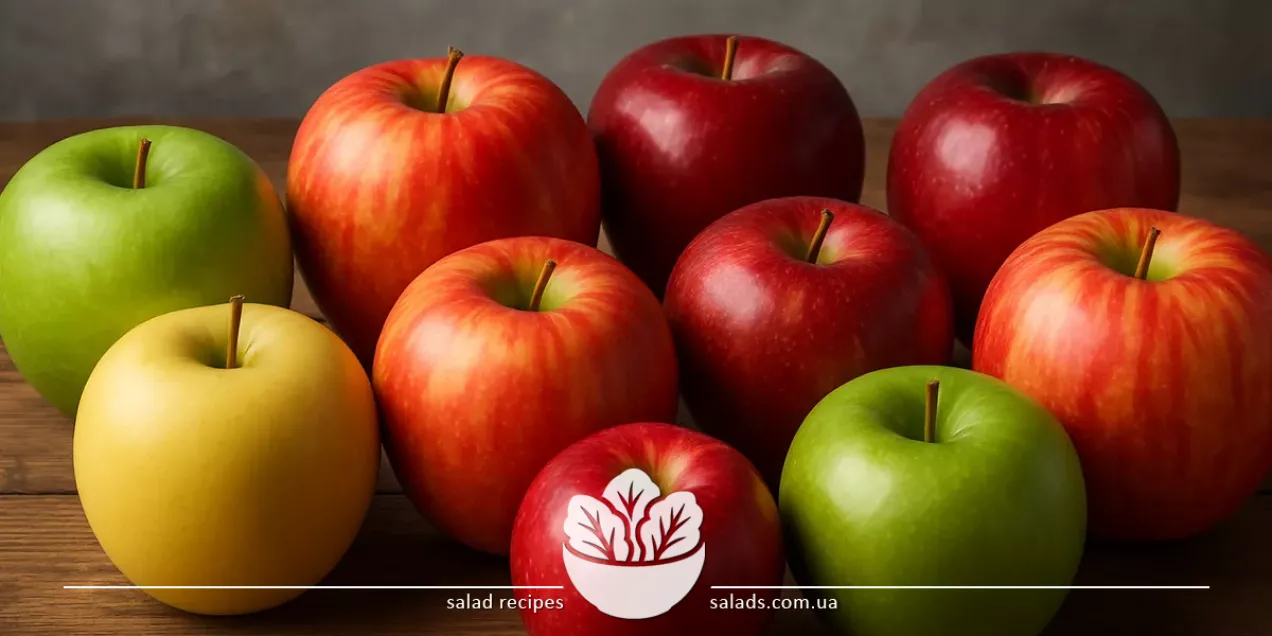Types of Apples

Types of apples include dozens of varieties with different tastes, textures, and culinary properties. Choosing apples for daily consumption or a specific dish involves not only taste preferences but also knowledge. Apples with firm flesh hold their shape well when baked, while juicy ones are perfect for juice or jam. Skin color, acidity, and aroma all help determine the ideal use of each variety. Among fruits, apples hold a special place – they store easily, are rich in vitamins, and suit both simple snacks and complex culinary creations.
Different Types of Apples
Sweet Apples: Best Varieties for Desserts
Among the many apple varieties, sweet types are the most popular among consumers. Their soft texture, lack of sharp acidity, and pleasant aroma make them versatile – great for everyday snacks as well as complex recipes. Well-known sweet varieties like “Gala,” “Fuji,” “Red Delicious,” and “Jonagold” are often brightly colored, with red or striped hues, and dense flesh that holds up well when baked. In desserts, sweet apples are widely used: they are added to apple cakes, strudels, muffins, baked with cinnamon, or caramelized in butter. These apples pair well with walnuts, raisins, honey, and vanilla. They are ideal for making apple jam or preserves – needing less added sugar. Sweet apples are also great for making dried fruit or fruit chips. In salads, sweet varieties balance salty or dairy components well. For example, in fruit-and-cheese dishes, apples are often paired with cheeses – soft, aged, or even blue varieties. This contrast of textures and flavors creates refined gastronomic combinations. If you’re looking for a light snack or raw dessert, a sweet apple is a perfect choice, especially for children.
Tart Apples: The Choice for Baking, Salads, and Marinades
Tart apples have a bright acidity, crisp flesh, and refreshing flavor, making them essential in many culinary applications. Popular varieties include “Granny Smith,” “Antonovka,” and “Bramley.” These apples are often green or yellow-green, with a firm texture and a long shelf life. This makes them ideal for baking – they don’t fall apart and maintain their shape in pies and casseroles. Tart varieties are commonly paired with meat: baked apples with duck, pork, or turkey enhance the dish’s flavor and provide a sweet-and-sour balance. They are also added to salads with nuts, celery, or chicken – for contrast and a bold flavor accent. For apple cider vinegar, cider, and meat marinades, tart apples are preferred because they contain more natural acids. Another popular use is in preservation. Antonovka, for instance, is widely used in homemade jam, compote, or purée. Tart apples pair especially well with aromatic spices like cinnamon, star anise, and cloves. In more complex salads or marinades, it’s a good idea to add a protein element such as chicken eggs to balance both the flavor and texture of the dish.
Apples for Juice and Cider: Varieties with Rich Aroma
When making juice, cider, or other beverages, it’s important to choose apples that are juicy, aromatic, and well-balanced in flavor. Both single-variety apples and blends – mixing sweet, tart, and astringent types – are used in commercial and home processing. Varieties like “Jonathan,” “Melrose,” and “Antonovka” produce thick, flavorful juice with a strong fruit profile that lasts even after pasteurization. In cider production, apples play a crucial role: sugar content and acidity directly affect the quality of the drink. Traditional cider apples combine astringency, tannins, and aromatic richness. In home use, apples from the garden are common, but ripeness must be considered: unripe apples are too tart, while overripe ones spoil quickly and aren’t suitable for storage or fermentation.
Fresh apple juice is an ideal base for smoothies, jellies, or fruit sauces. It can be mixed with other ingredients – for example, a broth made from mackerel or a light stock – to create unusual sauces for meat. Such combinations are common in modern gastronomy, in dishes that combine sweet, salty, and sour elements. Apples intended for juicing can also be used for jellies and confitures. Thanks to their natural pectin content, some varieties – especially sweet-tart ones – thicken well without added gelatin. That’s why they are often combined with other fruits or berries in jams, preserves, and mousses.
Universal Varieties: When Balanced Apples Are Best
There are many apple varieties that aren’t strictly sweet or tart – they have a balanced flavor, a crisp structure, and moderate juiciness. These are considered universal apples: equally suitable for raw consumption, baking, sauces, salads, or desserts. Examples include “Golden Delicious,” “Pinova,” “Delistar,” and various local cultivars popular in temperate climates. These apples are often chosen for school snacks or breakfasts – they typically have thin skins and pleasant flesh even when eaten raw. At the same time, they hold their shape well in apple cakes, strudels, and baked desserts. Universal apples are ideal for those who want one variety for many uses, without storing several different types at home.
Universal apples also combine well with other ingredients in dishes containing poultry, vegetables, or grains. For example, they can be added to casseroles or porridges with rice to create a fruity-sweet accent. Such dishes are great for children, athletes, or anyone who prefers a balanced diet. Another advantage is their long shelf life. Universal varieties tend to store better than others, allowing them to be used even weeks after harvest. This is especially helpful in autumn, when households prepare apples for winter – drying them or making apple purée for canning. They’re also convenient for travel or work – they don’t brown too quickly after being sliced.
Rare Varieties: Local Types and New Crossbreeds
In addition to well-known commercial varieties, many local, seasonal, and selectively bred apples are grown in smaller quantities. These varieties often have unique aromas, unusual shapes, or vibrant coloring. For example, pink-fleshed apples like “Red Love” are visually striking and high in antioxidant activity. Some local cultivars, such as “Calville Blanc d’Hiver” or “Renet Simirenko,” have long histories and are passed down through generations as part of culinary heritage. These apples don’t often reach supermarket shelves – they can be found at farmers’ markets, in private orchards, or in specialty shops. Their uniqueness makes them popular in restaurants for signature desserts, tasting menus, or regional cuisine. Many rare varieties are very juicy, making them ideal for fresh juices or salads where texture and aroma are key.
Some of these apples are organically grown without chemicals, increasing their nutritional value and popularity among those who favor a healthy lifestyle. When paired with ingredients like avocado, they can be used in modern fruit bowls, smoothies, or even sauces for fish. To fully understand each variety’s potential, it’s worth experimenting with baking, drying, or freezing. Modern breeding has introduced hybrids that combine disease resistance, high yields, and attractive consumer traits – such as apples that don’t brown when sliced or that offer an improved sugar-acid balance. These innovations are quickly gaining popularity among gardeners and chefs alike. Their potential is still being explored, but they’re appearing more and more often in home recipes and restaurant menus.
